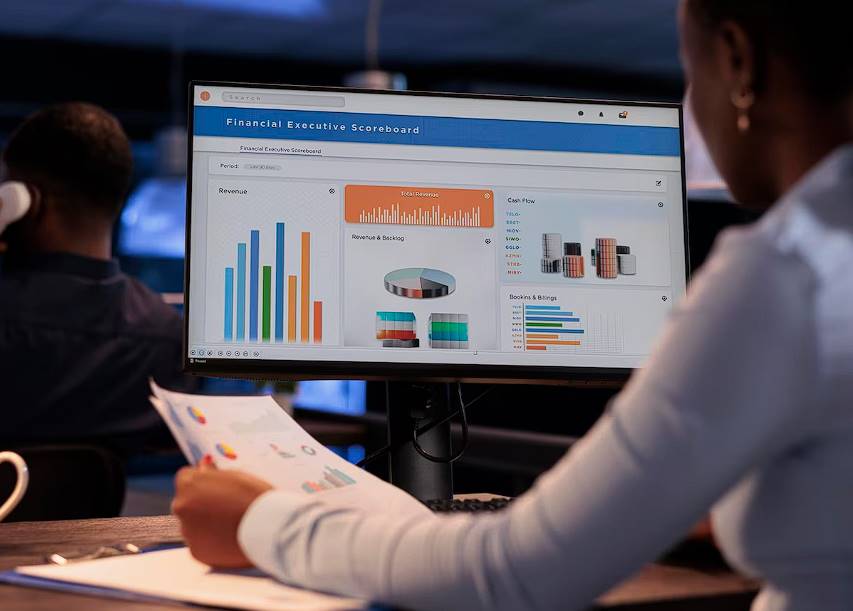The changing nature of how we work has had substantial effects on business privacy and security, particularly in the practice of network monitoring. A functional network acts as the foundation of any business. Through its ongoing procedure for vigilant surveillance, it not only ensures reliability but also facilitates optimal staff efficiency and robust security.
All network infrastructure components, including access to the network points, virtual computers, routers, servers, network devices, and switches, are constantly tracked to identify potential bottlenecks and evaluate overall performance as part of network monitoring, a crucial IT task. This includes monitoring essential performance indicators, such as CPU utilisation and network bandwidth.
Unquestionably, your company's network is paramount for its efficient operation. The carrying out of daily duties and operations depends on the network's functionality. By assuring the continual functioning of your network infrastructure, the adoption of continuous monitoring of networks is the solution to this problem. In this discussion, we will delve deeper into the importance of network monitoring.
How Can Network Monitoring Tools Benefit A Business Such As Yours?
The network is the most important part of computing operations, and ITOps workers are under a lot of pressure to make sure the network works as reliably as power.
By automating jobs like network learning, mapping, and business and IT network administration, network monitoring software makes it easier to switch from a reactive to a proactive strategy to network management. These tools not only make network maps, important alerts, and reports, but they also shorten the Mean Time to Resolution, which improves the experience for the end user.
Using network monitoring software benefits your organisation because it lets you control and monitor performance more proactively. This proactive method reduces downtime and lets you respond quickly to problems before they hurt your end users.
Why Monitor Your Networks?
Network tracking software can check how things are going in real-time, so if a problem or failure is found, you can be notified immediately, for example, by email. Because information is sent quickly, you can find out about network issues wherever you are. This lets you take action right away to fix the problem and minimise any downtime.
Also, network tracking software eliminates the need for a system administrator and checks done by hand. This can save your company a lot of time and cash, which means that the issue is solved well.
Another big benefit of network tracking is the reports it makes. These evaluations can help you find trends and patterns in how well a system works. They can also show that changes or replacements are needed. It's also easy to set up performance baselines.
Lastly, network monitoring tools can help you determine which parts of your network are having problems. This implies that you can quickly figure out the problem, saving valuable time when fixing it.
Here are a few more reasons why it's so important to keep an eye on your networks:
- Monitor patterns
- Anticipate action
- Remove the necessity for manual verifications
- Stay updated
- Identify problems
- Assess performance and availability metrics
- To enhance network efficiency and uptime,
- Diagnose problems
Network Monitoring's Advantages
Monitoring your network will help you find problems and fix them. It additionally helps you make your network run as well as it can. You can check the health of your network with network measures like packet restructuring, latency, jitters, and throughput.
Monitoring your network proactively will help you make sure your business keeps running. It helps you stay busy and avoid or shorten breaks. The main reasons why network tracking is a good idea are:
Stay Ahead of Outages
Why do IT systems go down? Human error, problems with the configuration, and the surroundings can all play a role. One of the most straightforward ways to stop these outages from occuring in the very first place is to set up network tracking.
Network tracking lets you see what's going on so you can stay a step ahead of problems. Network tracking software helps you find outages that could cause congestion by putting live network performance information in an easy-to-read format.
Visibility
Monitoring your network will ensure the IT department can see everything on your network. They can check everything on your apps and network. This is crucial because it will help you see how well your network performs. Network tracking is like going to the doctor, who will initially search for signs of trouble.
You can also find red flags with the help of network tracking. It will keep track of the information that moves through your network. You can check the whole data flow by keeping an eye on your network. If there is a problem, it is easy to figure out what caused it. This is going to assist you in solving the problem quickly.
Fix Issues Faster
When things are bad, time is money. Network monitoring makes it easier and faster for network workers who need more time to find solutions to problems.
Whether you're struggling with an error in configuration or a change in traffic that doesn't make sense, network tracking software can help you figure out what's happening. Live network maps help you determine where problems are coming from, and progress windows show how your network is doing over time.
Also, tools for network management help you take the next step. By keeping an eye on your network, you can not only find problems, but you can also fix them without engaging a person.
Better Network Reliability
The overall condition of your gadget can be checked with the help of network monitoring. It will tell you if your router, databases, server, and router are running well. After the item breaks, you don't have to worry about fixing it.
A proactive method of network tracking will help you keep your network in good shape. It will make sure that everything in your network is working well. So, network tracking will help you reduce the number of times your network is down. Your gadgets will always work right. If network equipment isn't working right, finding out what's wrong and fixing it is easy.
Gain Immediate ROI
IT teams have to deal with a lot of work and projects that are getting more complicated, but they often need more time, people, or money to finish them. With the right tool, the return on investment (ROI) can be seen immediately.
Staff have more time to work on more significant projects without looking into network speed by hand. Getting to the bottom of problems takes less time when you can see where they are coming from. And going ahead of IT problems reduces how much they cost your business.
Boost Network Performance
Your business and your network will only grow as time goes on. So, you'll add more gadgets to your network. Also, you will make your network's speed bigger to keep up with demand. Monitoring your network will help you keep track of your gadgets.
It will ensure you can check the status of the apps and devices your users are using. You should measure how well your network is doing right now. This could assist you in deciding what your network's goals should be. You can use system tracking to improve the performance of your network and, in the long run, beat your competitors.
Justify Equipment Upgrades
Most bosses won't believe you because you feel like a server needs to be updated. But a report detailing how tech has worked in the past year is much more convincing.
Network monitoring tools let you see how equipment has worked in the past so you can explain network upgrades. Trends examination helps you determine if your current technology can grow to meet business goals or if you need to buy new technology.
Better Use of Resources
Because of the outbreak, IT teams already have too much to do. After this pandemic, over 75 per cent of IT employees have taken on new jobs. If your network goes down, your employees won't be able to do their jobs. If your network goes down, your workers won't be able to do their jobs.
Network monitoring tools can help you ensure your network is in good shape. It will also cut down on physical labour. Your IT departments don't have to check your network by hand.
They can use automatic tools to check on your network right away. If your network goes down, they may quickly use these instruments to find problems. So they can quickly fix any problems with the network. This way, your IT team can work on other important projects.
What Is Network Infrastructure?
Your company's network infrastructure comprises all its hardware and software tools, like switches, routers, WiFi, firewalls, and servers. Each of these needs to be set up and maintained carefully.
- Firewalls protect your network by controlling the data that comes in from and goes out to networks you don't trust.
- Users' apps, databases, and other files are sent to them through a network from servers.
- Switches connect the computers, printers, and other devices in your secure network so they can talk to each other.
- Your routers link your devices to the web.
- Your computers, tablets, and phones can connect to the rest of the internet through WiFi access points.
What Are the Five Distinct Varieties of Network Management?
- Security management: Network authentication, authorisation, and reporting are all functions. Make sure that only people and devices with permission can use network resources.
- Performance management: Maintains acceptable service in the network to help the business run smoothly. This information can be fed to an SNMP management tool, which notifies network managers when service levels drop below or rise above acceptable limits.
- Accounting management: Records all information about how the network is used. This information is important for keeping the books and keeping track of costs.
- Configuration management: Outages are mostly caused by problems with how things are set up, so organisations need good tools and best practices for all parts of configuration management. One of the most important parts of managing configurations is keeping track of and writing down any changes to how network gear and software are set up.
- Fault management: Addresses the capacity to keep the whole infrastructure running by using a mix of technology and methods to find, fix, and record errors that could stop the network from working.
Conclusion
Businesses need to watch their networks to make sure they are reliable, their employees are working well, and they have strong security. It includes keeping track of all network infrastructure parts, such as access points, virtual computers, routers, servers, network devices, and switches, to find potential bottlenecks and measure overall performance. Network monitoring tools automate jobs like learning how a network works, making a map of it, and managing business and IT networks. This makes network management more proactive.
Network monitoring tools can check how well a network is working in real time, so problems or failures can be fixed right away. It gets rid of the need to check things by hand, which saves time and money. Network tracking software also makes reports that show trends and patterns in how well a system works, which shows if changes or replacements need to be made. It also helps find places with problems, which saves time when fixing them.
Businesses need network tracking to keep track of patterns, predict what will happen, get rid of the need for manual checks, stay up-to-date, find problems, evaluate performance and availability metrics, and improve network efficiency and uptime.
Businesses need network tracking to prevent outages, fix problems faster, and make their networks more reliable. It helps find possible bottlenecks caused by human error, configuration problems, or the surroundings. Network tracking software gives real-time information in an easy-to-read format about how the network is running. This lets IT teams keep an eye on the whole network and spot red flags.
Network tracking tools like live network maps and progress windows make it easier to find and fix problems faster. By keeping an eye on your network, you can find problems and fix them without involving a person. Network monitoring also makes networks more reliable by checking the general health of your devices and reducing the number of times they go down.
You can see the return on investment (ROI) of your IT assets right away if you use network monitoring tools. This lets the staff work on more important projects without having to worry about how fast the network is.
Network tracking can also help improve how well a network works. By keeping track of how apps and devices are doing, you can figure out the goals of the network and improve its performance over time. Monitoring tools can also help explain equipment upgrades by giving historical data that can be used to support upgrades or figure out if current technology can grow to meet business goals.
By using network tracking tools, IT teams can make sure their network is working well and cut down on the amount of manual work they have to do. They can use automatic tools to check on the network right away. This lets them fix any problems quickly and move on to more important projects.
The gear and software that make up a network's infrastructure are things like switches, routers, WiFi, firewalls, and servers. To protect data, control users' apps, and connect devices to the internet, these tools must be set up and kept in good shape. Security management, performance management, accounting management, setup management, and fault management are the five different types of network management.
Security management makes sure that only authorised users can access network resources. Performance management keeps service levels at a good level, accounting management keeps track of how the network is used, configuration management keeps track of and records changes to the configuration, and fault management uses technology and methods to deal with possible network problems.
Content Summary
- Network monitoring is crucial for modern business operations.
- A functional network is foundational to any business.
- Vigilant surveillance ensures network reliability and robust security.
- Monitoring covers access points, servers, routers, and other network components.
- Essential performance indicators like CPU utilisation are tracked.
- Network functionality is essential for daily operations in a company.
- Adopting continuous network monitoring assures optimal operation.
- ITOps workers face immense pressure to maintain network reliability.
- Network monitoring software enables a shift from reactive to proactive management.
- Automated tools facilitate network mapping and administration.
- These tools generate important alerts, reports, and network maps.
- Mean Time to Resolution is shortened, improving the end-user experience.
- Proactive monitoring lessens downtime.
- Immediate alerts, like emails, notify you of real-time issues.
- Manual checks by system administrators become unnecessary.
- Saves time and money for the company.
- Monitoring generates reports to identify system trends.
- Performance baselines can be easily set up.
- Network issues can be pinpointed rapidly.
- Network monitoring helps to anticipate actions.
- It allows you to stay updated about the network's state.
- Enables you to assess performance and availability metrics.
- You can diagnose problems quickly.
- Network measures like packet restructuring and latency are tracked.
- Proactive monitoring ensures the business keeps running.
- Monitoring helps stay ahead of outages.
- Human error and configuration problems can be pre-empted.
- Offers visibility into everything on your network.
- It's akin to a regular health check-up for your network.
- Red flags can be easily identified.
- Network workers can resolve issues faster.
- Live network maps help identify the origins of problems.
- Network monitoring can autonomously fix issues.
- Overall gadget condition is checked.
- Enhances network reliability and uptime.
- Offers immediate ROI by freeing up staff for significant projects.
- Justifies the need for equipment upgrades through historical data.
- Supports better use of IT resources.
- Network infrastructure comprises hardware and software tools.
- Firewalls control incoming and outgoing data.
- Servers facilitate the sending of apps, databases, and files.
- Switches connect devices within a secure network.
- Routers link your devices to the internet.
- WiFi access points enable internet connection for mobile devices.
- Security management covers network authentication and authorisation.
- Performance management maintains acceptable service levels.
- Accounting management keeps records of network usage.
- Configuration management minimises outages caused by setup issues.
- Fault management employs technology to find, fix, and record errors.
- Effective network management encompasses five distinct varieties: security, performance, accounting, configuration, and fault management.
Frequently Asked Questions
Network monitoring should make it possible to see an organisation's whole IT and network systems. Monitoring, solving, and fixing problems with how well a network works. Root cause analysis tools are used when problems happen.
Network monitoring is a very important part of IT. All networking components, such as switches, routers, firewalls, servers, and virtual machines (VMs), are constantly checked for faults and performance issues and evaluated to keep their uptime at their best. Monitoring a network should be proactive, which is an important part of it.
Product quality is consistent because production tracking lets manufacturers track the product and the procedure standards in real time. This gives operators and managers exact and up-to-date information about how the production run is going. If there are any problems or problems with consistency, the right people can step in.
SNMP (Simple Network Management Protocol) is a versatile tech that lets you control and monitor network performance devices, fix problems, and prepare for future network growth. Many network equipment support SNMP, so watching them with an SNMP-compatible option is easy.
Network monitoring is a system component that continually monitors the network's computers for slow or broken parts and alerts the network supervisor (via email, SMS, or other alarms) if there are outages or other problems. Monitoring the network is a part of managing the network.


